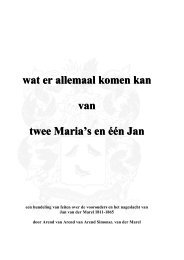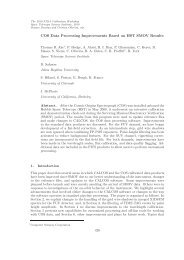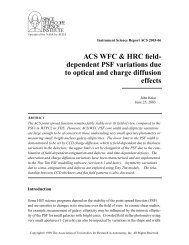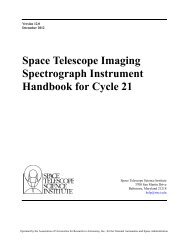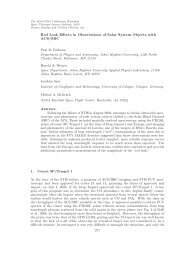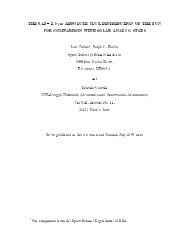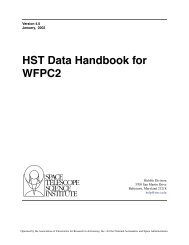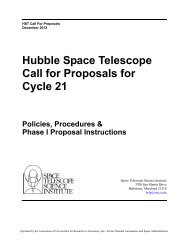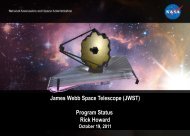STScI Annual Report 2002: A Living Mission
STScI Annual Report 2002: A Living Mission
STScI Annual Report 2002: A Living Mission
You also want an ePaper? Increase the reach of your titles
YUMPU automatically turns print PDFs into web optimized ePapers that Google loves.
Science with ACS: A New View<br />
— Adam G. Riess<br />
EVERYONE APPRECIATES A NICE VIEW, AND<br />
ASTRONOMERS ARE NO EXCEPTION. The new Advanced Camera<br />
for Surveys (ACS) offers them twice the field of view and five times the depth<br />
of the Wide Field and Planetary Camera 2, its predecessor as the primary<br />
Hubble imaging instrument. They have used this increased grasp of light for<br />
many investigations in its first observing cycle. Although astronomers will<br />
need a year or more to analyze and draw conclusions from these early ACS<br />
observations, a number of exciting discoveries, confirmations, and controversies<br />
are already emerging.<br />
One issue is whether galaxies at redshift z > 6 are less numerous than expected<br />
from the 1995 Hubble Deep Field North (HDFN) investigation. The team that<br />
developed ACS, led by Principal Investigator (PI) Holland Ford and deputy PI Garth<br />
Illingworth, reported an abundance of high-redshift galaxies in new images of the<br />
HDFN and in the background of their images of low redshift galaxies, like the<br />
Tadpole and the Mice, which were early-release observations. Nevertheless, the<br />
ACS team found a surprising lack of galaxies at z > 6—fewer by factor five to ten<br />
than expected from extrapolating the z ~ 5 sample in the original HDFN study.<br />
Meanwhile, another group has claimed the detection of ~ 30 galaxies at z ~ 6<br />
using the ‘drop-out’ search technique, with the criterion that the object is present<br />
in the z-band image but absent in the I-band image.<br />
The ACS team invested 20 Hubble orbits to obtain a stunning deep image of a<br />
massive cluster of galaxies, Abell 1689. The image shows red elliptical galaxies<br />
framed by spidery blue arcs of strongly lensed background sources. By analyzing<br />
the separations of pairs of background sources—including one as distant as z = 4.9—<br />
they measured the cluster mass within the Einstein radius of its lens to be 1.5 x 1014 solar masses, a value in good agreement with the estimate from X-ray studies.



